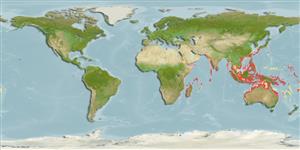Common names from other countries
Environment: milieu / climate zone / depth range / distribution range
पारिस्थितिकी
समुद्री; खारा प्रवाल-भित्ति संयुक्त; गहराई सीमा 0 - 40 m (Ref. 90102). Tropical
Indo-West Pacific: India to China, Philippines, Papua New Guinea and Australia. Reported from Vanuatu (Ref. 13300).
आकार / वज़न / Age
Maturity: Lm ? range ? - ? cm
Max length : 60.0 cm TL पुल्लिंग / अलिंग; (Ref. 4690)
पृष्ठीय रीढ़ (सम्पूर्ण) : 13 - 14; पृष्ठीय सौफट रेज़ (सम्पूर्ण) : 6; गुदा कांटा: 3; ऐनल सौफट रेज़: 5. A drab species, usually brownish grey to reddish brown with a pattern of fine lines across the caudal fin. Eyes well elevated compared to the reef stonefish S. verrucosa (Ref. 48635).
Inhabits coastal reefs and estuaries (Ref. 9710). Makes a shallow depression by scooping up sand or mud with its pectoral fins until it is piled up around the sides of its body. Lies motionless on sandy bottom areas. Comes out at night and often moves on top of reefs (Ref. 48635). In Guinness Book of Records as most venomous fish (Ref. 6472). Solitary in coral rubble and rocks, extremely difficult to detect (Ref 90102).
Life cycle and mating behavior
Maturities | पुनरुत्पत्ति | Spawnings | Egg(s) | Fecundities | लार्वा
Randall, J.E., G.R. Allen and R.C. Steene, 1990. Fishes of the Great Barrier Reef and Coral Sea. University of Hawaii Press, Honolulu, Hawaii. 506 p. (Ref. 2334)
IUCN Red List Status (Ref. 130435)
CITES (Ref. 128078)
Not Evaluated
Human uses
मात्स्यिकी: व्यापारिक; जलजीवालय: सार्वजनिक लजीवालय
साधन
Special reports
Download XML
इंटरनेट स्रोत
Estimates based on models
Preferred temperature (Ref.
115969): 24.4 - 29, mean 27.9 (based on 874 cells).
Phylogenetic diversity index (Ref.
82804): PD
50 = 0.5312 [Uniqueness, from 0.5 = low to 2.0 = high].
Bayesian length-weight: a=0.01622 (0.00609 - 0.04318), b=3.05 (2.82 - 3.28), in cm Total Length, based on LWR estimates for this (Sub)family-body shape (Ref.
93245).
Trophic level (Ref.
69278): 4.4 ±0.8 se; based on size and trophs of closest relatives
लौटाव (Ref.
120179): बहुत नीचे, न्यूनतम जनसंख्या दुगनी समय अवलागत 14 महीने। (Preliminary K or Fecundity.).
Fishing Vulnerability (Ref.
59153): Moderate vulnerability (44 of 100).
